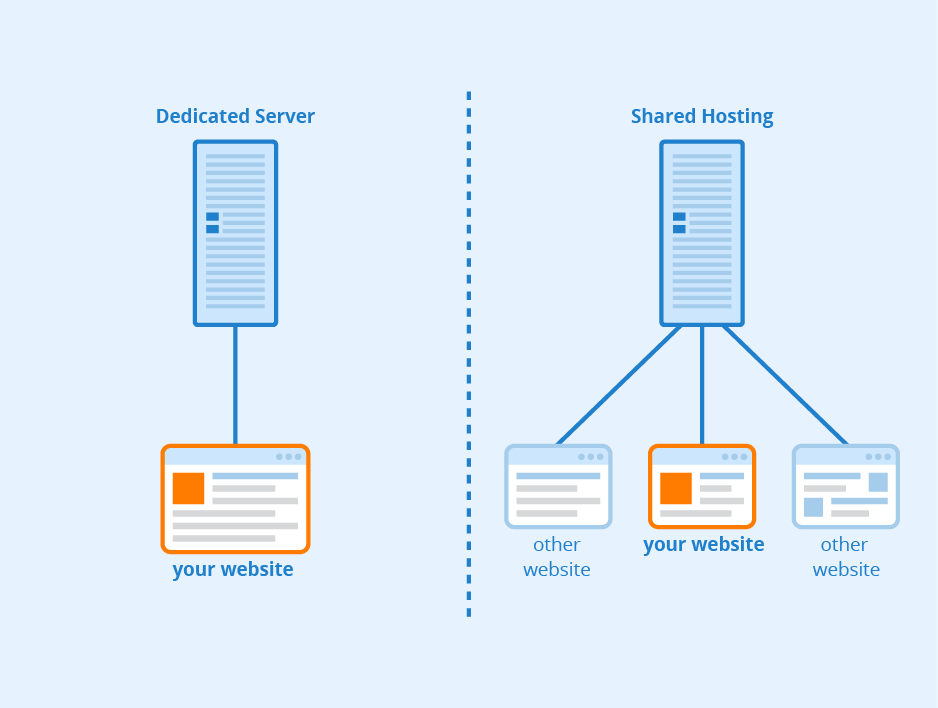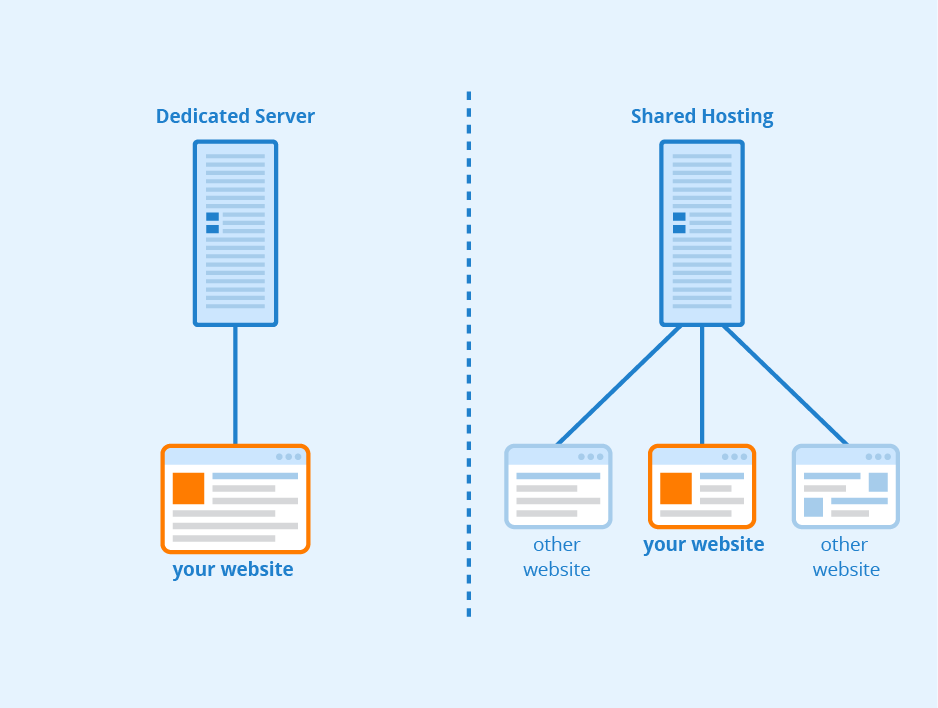Shared hosting is a widely used web hosting solution that allows multiple websites to share resources on a single server. This cost-effective option is perfect for small businesses and individuals looking to establish an online presence without the need for a dedicated server. But how does it actually work?
When you choose shared hosting for your website, your files and data are stored on a server that is shared with other websites. This means that the server’s resources, such as storage space, bandwidth, and processing power, are divided among multiple users. While this may sound like a potential drawback, reputable hosting providers carefully manage and allocate these resources to ensure optimal performance for all users. With shared hosting, you can enjoy affordability, convenience, and reliable support, making it an excellent choice for beginners and those with moderate traffic.
Shared hosting works by hosting multiple websites on a single server. These websites share the server’s resources, including CPU, RAM, and disk space. By sharing the costs, shared hosting is an affordable option for individuals and small businesses. However, the sharing of resources means that the performance can be affected if other websites on the server experience high traffic. It’s important to choose a reliable hosting provider to ensure optimal performance and security.

How Does Shared Hosting Work? An Overview
Shared hosting is one of the most popular types of web hosting, and it is often recommended for individuals and small businesses who are just starting their online presence. But how does shared hosting work? In this article, we will explore the ins and outs of shared hosting, including what it is, how it works, and its advantages and disadvantages.
Shared hosting essentially means that multiple websites are hosted on a single server. Think of it as a shared apartment building with multiple tenants. Each tenant has their own separate space, but they share the resources of the building, such as electricity, water, and maintenance. Similarly, in shared hosting, each website has its own space and resources, but they all share the same server.
This type of hosting is cost-effective because the server resources are shared among multiple users, making it more affordable compared to other types of hosting, such as dedicated hosting. However, since resources are shared, there may be limitations on bandwidth, storage, and processing power, depending on the hosting plan and the number of websites hosted on the server. Now that we have a basic understanding, let’s dive deeper into how shared hosting actually works.
How Shared Hosting Works: The Server Environment
In shared hosting, all the websites hosted on a server share the same physical hardware and server resources. The server environment typically consists of a powerful computer with high-speed internet connectivity, multiple hard drives for storage, and software that manages the hosting operations.
When you sign up for a shared hosting plan, your website’s files and data are stored on the server, along with the files and data of other websites on the same server. Each website is assigned a specific amount of disk space on the server to store its files, including HTML, CSS, images, videos, and databases.
The server’s operating system and hosting software manage the allocation of server resources to each website. This includes processing power (CPU), memory (RAM), and bandwidth. The hosting software also ensures that each website runs independently and securely, without affecting the performance or security of other websites on the server.
Now that we have covered the server environment, let’s explore how shared hosting divides and allocates resources among different websites on the server.
Resource Allocation in Shared Hosting
In shared hosting, the server resources are divided and allocated among the websites hosted on the server. Each website is given a specific share of the server resources, including CPU, RAM, and bandwidth. The hosting provider sets these resource limits based on the hosting plan you choose.
For example, if you have a basic shared hosting plan, you may have limited CPU usage, a certain amount of RAM, and a specific bandwidth limit. If your website exceeds these resource limits, it may slow down or experience performance issues. That’s why it’s important to choose a hosting plan that meets your website’s needs.
The hosting software on the server actively monitors the resource usage of each website. If a website is using an excessive amount of resources, it may impact the performance of other websites on the server. To ensure fair resource allocation, hosting providers often implement measures, such as CPU throttling or limiting resource usage, to prevent one website from hogging all the resources.
It’s worth noting that shared hosting plans often have scalability options, allowing you to upgrade to a higher plan if your website outgrows its current resource limits. This scalability is beneficial for websites that experience growth and increased traffic over time.
Advantages of Shared Hosting
Shared hosting offers several advantages that make it a popular choice for individuals and small businesses:
- Affordability: Shared hosting is one of the most budget-friendly options available, making it ideal for those with limited financial resources.
- Ease of use: Shared hosting plans usually come with user-friendly interfaces and pre-installed software, making it easy for beginners to set up and manage their websites.
- Technical maintenance: With shared hosting, the hosting provider takes care of server maintenance, security patches, and software updates, allowing you to focus on building and growing your website.
- Scalability: Shared hosting plans often offer scalability options, allowing you to easily upgrade your resources as your website grows.
However, shared hosting also has some drawbacks that are important to consider.
Disadvantages of Shared Hosting
While shared hosting has many advantages, there are a few potential downsides:
- Resource limitations: Since resources are shared among multiple websites, there may be limitations on bandwidth, storage, and processing power. If your website experiences high traffic or resource-intensive operations, it may be affected by these limitations.
- Security risks: The shared nature of the server means that if one website on the server is compromised, it can potentially affect other websites as well. However, reputable hosting providers implement security measures to minimize these risks.
- Performance fluctuations: If one website on the server experiences a sudden surge in traffic or utilizes a significant amount of resources, it can impact the performance of other websites on the same server. This is known as the “bad neighbor effect.”
Considering these advantages and disadvantages is crucial when deciding whether shared hosting is the right choice for your website. Now that we have covered the basics of how shared hosting works and its pros and cons, it’s time to wrap up this article.
Conclusion
Shared hosting is a popular and cost-effective option for individuals and small businesses looking to establish their online presence. It works by hosting multiple websites on a single server and allocating shared resources. While it offers affordability and ease of use, it also comes with resource limitations and potential performance fluctuations. Carefully consider your website’s needs and weigh the advantages and disadvantages to determine if shared hosting is the right fit for you.
When choosing a shared hosting provider, it’s important to prioritize a reputable and reliable company that offers excellent customer support, adequate security measures, and scalability options to accommodate your website’s growth. With the right shared hosting plan, you can take your website from inception to success.
Key Takeaways – How Does Shared Hosting Work?
- Shared hosting is a type of web hosting where multiple websites are hosted on a single server.
- Resources like CPU, RAM, and disk space are shared among all the websites on the server.
- Shared hosting is an affordable option for small websites with low traffic.
- It has some limitations, such as limited security and performance compared to other hosting options like dedicated or VPS hosting.
- Shared hosting providers manage server maintenance and technical support for the websites.
Shared hosting is a type of web hosting where multiple websites are hosted on a single server. This means that the resources of the server, such as disk space, bandwidth, and processing power, are shared among all the websites on that server.
When you sign up for shared hosting, you are essentially renting a portion of the server’s resources for your website. This makes it an affordable option for individuals and small businesses who don’t need the dedicated resources of an entire server.
However, since the resources are shared, the performance of your website can be affected by the activities of other websites on the same server. If one website experiences a surge in traffic or consumes excessive resources, it can impact the performance of other websites on the server.
In summary, shared hosting allows multiple websites to be hosted on a single server, sharing its resources. It is a cost-effective option, but the performance of your website can be influenced by other websites on the same server.

